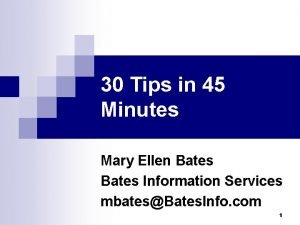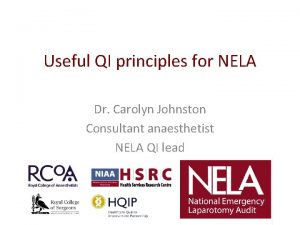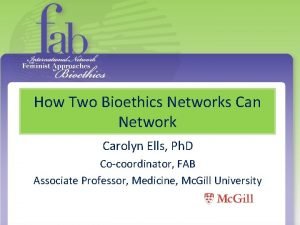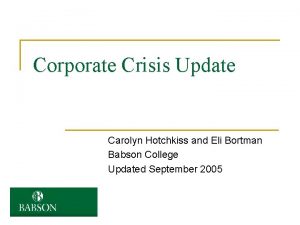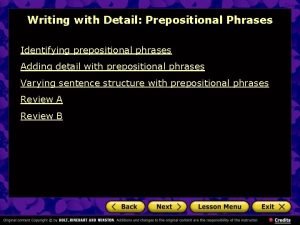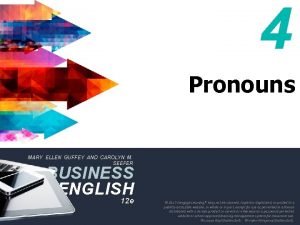8 Prepositions MARY ELLEN GUFFEY AND CAROLYN M


































- Slides: 34

8 Prepositions MARY ELLEN GUFFEY AND CAROLYN M. SEEFER BUSINESS ENGLISH 12 e © 2017 Cengage Learning®. May not be scanned, copied or duplicated, or posted to a publicly accessible website, in whole or in part, except for use as permitted in a license distributed with a certain product or service or otherwise on a password-protected website or school-approved learning management system for classroom use. © Larysa Ray/Shutterstock. © Valeri Potapova/Shutterstock.

LEARNING OUTCOMES Level 1 ▶ Use objective-case pronouns as objects of prepositions. ▶ Avoid using prepositions in place of verbs and adverbs. © 2017 Cengage Learning®. May not be scanned, copied or duplicated, or posted to a publicly accessible website, in whole or in part, except for use as permitted in a license distributed with a certain product or service or otherwise on a password-protected website or school-approved learning management system for classroom use. © Larysa Ray/Shutterstock 2

Commonly Used Prepositions about above according to after along with at before between beside but by due to during except for from in/into like near of on to under with © © 2017 Cengage Learning®. May not be be scanned, copied or or duplicated, or or posted to to a a publicly accessible website, in in whole or or in in part, except for use as as permitted in in a a license distributed with a license with a certain product service or otherwise on a password-protected website or school-approved learning management for Ray/Shutterstock classroom use. certain distributed product or service or otherwise onor a password-protected website or school-approved learning management system for classroom use. system © Larysa Ray/Shutterstock 3

Prepositional Phrases A preposition often appears in a prepositional phrase: Preposition + Object = Prepositional Phrase The object of a preposition is a noun or pronoun. She placed her briefcase under her desk. We really need to hire an intern like him. © © 2017 Cengage Learning®. May not be be scanned, copied or or duplicated, or or posted to to a a publicly accessible website, in in whole or or in in part, except for use as as permitted in in a a license distributed with a license with a certain product service or otherwise on a password-protected website or school-approved learning management for Ray/Shutterstock classroom use. certain distributed product or service or otherwise onor a password-protected website or school-approved learning management system for classroom use. system © Larysa Ray/Shutterstock 4

Objective Case Following Prepositions Use objective-case pronouns (me, us, you, him, her, it, and them) as objects of prepositions. Everyone except Leslie and her arrived early. Just between you and me, sales are increasing. © © 2017 Cengage Learning®. May not be be scanned, copied or or duplicated, or or posted to to a a publicly accessible website, in in whole or or in in part, except for use as as permitted in in a a license distributed with a license with a certain product service or otherwise on a password-protected website or school-approved learning management for Ray/Shutterstock classroom use. certain distributed product or service or otherwise onor a password-protected website or school-approved learning management system for classroom use. system © Larysa Ray/Shutterstock 5

Typical Problems With Prepositions Using of for have Using off for from Using to for too © © 2017 Cengage Learning®. May not be be scanned, copied or or duplicated, or or posted to to a a publicly accessible website, in in whole or or in in part, except for use as as permitted in in a a license distributed with a license with a certain product service or otherwise on a password-protected website or school-approved learning management for Ray/Shutterstock classroom use. certain distributed product or service or otherwise onor a password-protected website or school-approved learning management system for classroom use. system © Larysa Ray/Shutterstock 6

Using of for have Do not substitute the preposition of for the verb have. They should have (not of ) walked to the restaurant. We could have (not of ) received free tickets. We would have (not of ) attended the concert if we had known about it. © © 2017 Cengage Learning®. May not be be scanned, copied or or duplicated, or or posted to to a a publicly accessible website, in in whole or or in in part, except for use as as permitted in in a a license distributed with a license with a certain product service or otherwise on a password-protected website or school-approved learning management for Ray/Shutterstock classroom use. certain distributed product or service or otherwise onor a password-protected website or school-approved learning management system for classroom use. system © Larysa Ray/Shutterstock 7

Using off for from Do not replace the preposition from with the words off or off of. Can I get the user data from (not off or off of ) you? Christine borrowed the pen from (not off or off of ) Brandon. © © 2017 Cengage Learning®. May not be be scanned, copied or or duplicated, or or posted to to a a publicly accessible website, in in whole or or in in part, except for use as as permitted in in a a license distributed with a license with a certain product service or otherwise on a password-protected website or school-approved learning management for Ray/Shutterstock classroom use. certain distributed product or service or otherwise onor a password-protected website or school-approved learning management system for classroom use. system © Larysa Ray/Shutterstock 8

Using to for too Do not use the preposition to ( “in a direction toward”) in place of the adverb too (“additionally, ” “also, ” or “excessively”). Give the cash receipts to the courier. Sales reps received tablets and smartphones too. The car was too small to carry the equipment. © © 2017 Cengage Learning®. May not be be scanned, copied or or duplicated, or or posted to to a a publicly accessible website, in in whole or or in in part, except for use as as permitted in in a a license distributed with a license with a certain product service or otherwise on a password-protected website or school-approved learning management for Ray/Shutterstock classroom use. certain distributed product or service or otherwise onor a password-protected website or school-approved learning management system for classroom use. system © Larysa Ray/Shutterstock 9

TRY YOUR SKILL Choose the correct word to complete these sentences. 1. Between you and (I/me), I didn’t like his idea. 2. We should (have/of) arrived earlier. 3. Suzanne borrowed some money (off of/from) her daughter. 4. The rent for this office space is (to/too) high. © 2017 Cengage Learning®. May not be scanned, copied or duplicated, or posted to a publicly accessible website, in whole or in part, except for use as permitted in a license distributed with a certain product or service or otherwise on a password-protected website or school-approved learning management system for classroom use. © Larysa Ray/Shutterstock 10

LEARNING OUTCOMES Level 2 ▶ Use challenging prepositions correctly. ▶ Retain necessary prepositions, omit unnecessary ones, and construct formal sentences that avoid terminal prepositions. © 2017 Cengage Learning®. May not be scanned, copied or duplicated, or posted to a publicly accessible website, in whole or in part, except for use as permitted in a license distributed with a certain product or service or otherwise on a password-protected website or school-approved learning management system for classroom use. © Larysa Ray/Shutterstock 11

Challenges With Prepositions Commonly Confused Prepositions Necessary Prepositions Unnecessary Prepositions Ending a Sentence With a Preposition © © 2017 Cengage Learning®. May not be be scanned, copied or or duplicated, or or posted to to a a publicly accessible website, in in whole or or in in part, except for use as as permitted in in a a license distributed with a license with a certain product service or otherwise on a password-protected website or school-approved learning management for Ray/Shutterstock classroom use. certain distributed product or service or otherwise onor a password-protected website or school-approved learning management system for classroom use. system © Larysa Ray/Shutterstock 12

Commonly Confused Prepositions Among, Between Except Beside, Besides In, Into, In to Like © © 2017 Cengage Learning®. May not be be scanned, copied or or duplicated, or or posted to to a a publicly accessible website, in in whole or or in in part, except for use as as permitted in in a a license distributed with a license with a certain product service or otherwise on a password-protected website or school-approved learning management for Ray/Shutterstock classroom use. certain distributed product or service or otherwise onor a password-protected website or school-approved learning management system for classroom use. system © Larysa Ray/Shutterstock

Among, Between Among: used to speak of three or more persons or things Between: used to speak of two persons or things Profits will be divided among the nine partners. Responsibility will be divided between the vice president and the general manager. © © 2017 Cengage Learning®. May not be be scanned, copied or or duplicated, or or posted to to a a publicly accessible website, in in whole or or in in part, except for use as as permitted in in a a license distributed with a license with a certain product service or otherwise on a password-protected website or school-approved learning management for Ray/Shutterstock classroom use. certain distributed product or service or otherwise onor a password-protected website or school-approved learning management system for classroom use. system © Larysa Ray/Shutterstock

Beside, Besides Beside: means “next to” Besides: means “in addition to” You have another option besides this one. The carpool parking lot is beside the office. © © 2017 Cengage Learning®. May not be be scanned, copied or or duplicated, or or posted to to a a publicly accessible website, in in whole or or in in part, except for use as as permitted in in a a license distributed with a license with a certain product service or otherwise on a password-protected website or school-approved learning management for Ray/Shutterstock classroom use. certain distributed product or service or otherwise onor a password-protected website or school-approved learning management system for classroom use. system © Larysa Ray/Shutterstock

Except (preposition): means “but” or excluding” Accept (verb): means “to receive” All pages except three must be edited. We will accept applications for the position online. © © 2017 Cengage Learning®. May not be be scanned, copied or or duplicated, or or posted to to a a publicly accessible website, in in whole or or in in part, except for use as as permitted in in a a license distributed with a license with a certain product service or otherwise on a password-protected website or school-approved learning management for Ray/Shutterstock classroom use. certain distributed product or service or otherwise onor a password-protected website or school-approved learning management system for classroom use. system © Larysa Ray/Shutterstock

In, Into, In to In: indicates a position or location He is interested in underwater photography. The event took place in the new World Trade Center in New York City. © © 2017 Cengage Learning®. May not be be scanned, copied or or duplicated, or or posted to to a a publicly accessible website, in in whole or or in in part, except for use as as permitted in in a a license distributed with a license with a certain product service or otherwise on a password-protected website or school-approved learning management for Ray/Shutterstock classroom use. certain distributed product or service or otherwise onor a password-protected website or school-approved learning management system for classroom use. system © Larysa Ray/Shutterstock

In, Into, In to Into (one word): means three things: Entering something Changing form Making contact Entering into something She plans to go into accounting. We will move into our new building soon. Changing form He is turning into a talented musician. The caterpillar changed into a butterfly. Making contact I just ran into an old high school friend. The player ran into the outfield wall. © © 2017 Cengage Learning®. May not be be scanned, copied or or duplicated, or or posted to to a a publicly accessible website, in in whole or or in in part, except for use as as permitted in in a a license distributed with a license with a certain product service or otherwise on a password-protected website or school-approved learning management for Ray/Shutterstock classroom use. certain distributed product or service or otherwise onor a password-protected website or school-approved learning management system for classroom use. system © Larysa Ray/Shutterstock

In, Into, In to (two words): the adverb in preceding an infinitive or a prepositional phrase She went in to see the doctor to get her lab results. (to see is an infinitive) Please turn the report in to your boss on time. (to your boss is a prepositional phrase) © © 2017 Cengage Learning®. May not be be scanned, copied or or duplicated, or or posted to to a a publicly accessible website, in in whole or or in in part, except for use as as permitted in in a a license distributed with a license with a certain product service or otherwise on a password-protected website or school-approved learning management for Ray/Shutterstock classroom use. certain distributed product or service or otherwise onor a password-protected website or school-approved learning management system for classroom use. system © Larysa Ray/Shutterstock

Like The preposition like should be used to introduce nouns or pronouns. Do not use like to introduce clauses. My friend looks a lot like Natalie Portman. I wish I could sing like him. I feel as if (not like) I don’t have enough time to complete the project. He looks as though (not like) he didn’t get enough sleep last night. © © 2017 Cengage Learning®. May not be be scanned, copied or or duplicated, or or posted to to a a publicly accessible website, in in whole or or in in part, except for use as as permitted in in a a license distributed with a license with a certain product service or otherwise on a password-protected website or school-approved learning management for Ray/Shutterstock classroom use. certain distributed product or service or otherwise onor a password-protected website or school-approved learning management system for classroom use. system © Larysa Ray/Shutterstock

Necessary Prepositions Be sure to include those prepositions necessary to clarify a relationship. Be particularly careful when two prepositions modify a single object. Our appreciation for and interest in the project remain great. (Do not omit for. ) What style of interview suit do you prefer? (Do not omit of. ) She graduated from high school last year. (Do not omit from. ) © © 2017 Cengage Learning®. May not be be scanned, copied or or duplicated, or or posted to to a a publicly accessible website, in in whole or or in in part, except for use as as permitted in in a a license distributed with a license with a certain product service or otherwise on a password-protected website or school-approved learning management for Ray/Shutterstock classroom use. certain distributed product or service or otherwise onor a password-protected website or school-approved learning management system for classroom use. system © Larysa Ray/Shutterstock 21

Unnecessary Prepositions Omit unnecessary prepositions. I’m not sure when the meeting is scheduled for. (not “scheduled for”) The delivery was left outside of the door. (not “outside of”) Where would you like to meet at? (not “meet at”) Did that earthquake this morning wake you up? (not “wake you up”) © © 2017 Cengage Learning®. May not be be scanned, copied or or duplicated, or or posted to to a a publicly accessible website, in in whole or or in in part, except for use as as permitted in in a a license distributed with a license with a certain product service or otherwise on a password-protected website or school-approved learning management for Ray/Shutterstock classroom use. certain distributed product or service or otherwise onor a password-protected website or school-approved learning management system for classroom use. system © Larysa Ray/Shutterstock 22

Ending a Sentence With a Preposition In formal writing, careful writers avoid ending sentences with prepositions. Less Formal More Formal What topic did he lecture on? On what topic did he Whom do you wish to speak to? To whom do you wish to lecture? speak? © © 2017 Cengage Learning®. May not be be scanned, copied or or duplicated, or or posted to to a a publicly accessible website, in in whole or or in in part, except for use as as permitted in in a a license distributed with a license with a certain product service or otherwise on a password-protected website or school-approved learning management for Ray/Shutterstock classroom use. certain distributed product or service or otherwise onor a password-protected website or school-approved learning management system for classroom use. system © Larysa Ray/Shutterstock 23

TRY YOUR SKILL Choose the correct word to complete these sentences. 1. Let’s divide the pizza evenly (between/among) the two of us. 2. Dividends will be divided (between/among) all stockholders. 3. The break room is located (beside/besides) the copy room. © 2017 Cengage Learning®. May not be scanned, copied or duplicated, or posted to a publicly accessible website, in whole or in part, except for use as permitted in a license distributed with a certain product or service or otherwise on a password-protected website or school-approved learning management system for classroom use. © Larysa Ray/Shutterstock 24

TRY YOUR SKILL Choose the correct word to complete these sentences. 4. (Beside/Besides) your résumé, please send us a list of references. 5. Everyone (except/accept) him was given a raise. 6. You should go (into/in to) see your boss after lunch. © 2017 Cengage Learning®. May not be scanned, copied or duplicated, or posted to a publicly accessible website, in whole or in part, except for use as permitted in a license distributed with a certain product or service or otherwise on a password-protected website or school-approved learning management system for classroom use. © Larysa Ray/Shutterstock 25

TRY YOUR SKILL Choose the correct word to complete these sentences. 7. He made quite an impression when he walked (into/in to) the room. 8. She looks (like/as if) she would be an excellent employee. 9. Did the applicant (graduate/graduate from) college? © 2017 Cengage Learning®. May not be scanned, copied or duplicated, or posted to a publicly accessible website, in whole or in part, except for use as permitted in a license distributed with a certain product or service or otherwise on a password-protected website or school-approved learning management system for classroom use. © Larysa Ray/Shutterstock 26

LEARNING OUTCOMES Level 3 ▶ Recognize idioms and idiomatic constructions. ▶ Use idioms involving prepositions correctly. © 2017 Cengage Learning®. May not be scanned, copied or duplicated, or posted to a publicly accessible website, in whole or in part, except for use as permitted in a license distributed with a certain product or service or otherwise on a password-protected website or school-approved learning management system for classroom use. © Larysa Ray/Shutterstock 27

Idiomatic Use of Prepositions Idioms are word combinations that are unique to a specific language. These combinations have developed over time through usage and often cannot be explained rationally. In English learn to use specific prepositions with particular words. © © 2017 Cengage Learning®. May not be be scanned, copied or or duplicated, or or posted to to a a publicly accessible website, in in whole or or in in part, except for use as as permitted in in a a license distributed with a license with a certain product service or otherwise on a password-protected website or school-approved learning management for Ray/Shutterstock classroom use. certain distributed product or service or otherwise onor a password-protected website or school-approved learning management system for classroom use. system © Larysa Ray/Shutterstock 28

Idiomatic Expressions Examples Agree on mutual ideas Agree to a proposal or to undertake an action Agree with a person or his or her idea Angry about a situation or condition Angry at a thing Angry with a person Correspond to a thing Correspond with a person Differ from things Differ with persons Different from (not than) © © 2017 Cengage Learning®. May not be be scanned, copied or or duplicated, or or posted to to a a publicly accessible website, in in whole or or in in part, except for use as as permitted in in a a license distributed with a license with a certain product service or otherwise on a password-protected website or school-approved learning management for Ray/Shutterstock classroom use. certain distributed product or service or otherwise onor a password-protected website or school-approved learning management system for classroom use. system © Larysa Ray/Shutterstock 29

Idiomatic Expressions Examples Expert in Interest in Negligent of Plan to (not on) Reconcile with (match) Reconcile to (accept) Respect for Retroactive to (not from) Speak/Talk to (tell something) Speak/Talk with (discuss with) Standing in line (not on line) © © 2017 Cengage Learning®. May not be be scanned, copied or or duplicated, or or posted to to a a publicly accessible website, in in whole or or in in part, except for use as as permitted in in a a license distributed with a license with a certain product service or otherwise on a password-protected website or school-approved learning management for Ray/Shutterstock classroom use. certain distributed product or service or otherwise onor a password-protected website or school-approved learning management system for classroom use. system © Larysa Ray/Shutterstock 30

TRY YOUR SKILL Choose the correct word to complete these sentences. 1. No one will agree (to/with) such a crazy plan. 2. Lance was quite angry (at/with) his boss after the meeting. 3. The presidential debate will center (around/on) foreign policy. © 2017 Cengage Learning®. May not be scanned, copied or duplicated, or posted to a publicly accessible website, in whole or in part, except for use as permitted in a license distributed with a certain product or service or otherwise on a password-protected website or school-approved learning management system for classroom use. © Larysa Ray/Shutterstock 31

TRY YOUR SKILL Choose the correct word to complete these sentences. 4. My new job is very different (from/than) my old one. 5. Salary adjustments are retroactive (from/to) July 1. 6. Mandy is adept (at/in) communicating. 7. Brad has great interest (for/in) the stock market. © 2017 Cengage Learning®. May not be scanned, copied or duplicated, or posted to a publicly accessible website, in whole or in part, except for use as permitted in a license distributed with a certain product or service or otherwise on a password-protected website or school-approved learning management system for classroom use. © Larysa Ray/Shutterstock 32

TRY YOUR SKILL Choose the correct word to complete these sentences. 8. Do you plan (on going/ to go) to graduate school? 9. Do you consider yourself an expert (at/in) estate planning? 10. Will the mediator be able to get the parties to talk (to/with) one another? © 2017 Cengage Learning®. May not be scanned, copied or duplicated, or posted to a publicly accessible website, in whole or in part, except for use as permitted in a license distributed with a certain product or service or otherwise on a password-protected website or school-approved learning management system for classroom use. © Larysa Ray/Shutterstock 33

“All speech, written or spoken, is a dead language, until it finds a willing and prepared hearer. ” – Robert Louis Stevenson, Scottish novelist/poet/ essayist/travel writer (18501894) © 2017 Cengage Learning®. May not be scanned, copied or duplicated, or posted to a publicly accessible website, in whole or in part, except for use as permitted in a © 2017 Cengagewith Learning®. May not be or duplicated, or posted to a publicly website, in learning whole ormanagement in part, except for useforasclassroom permitteduse. in a license distributed with a license distributed a certain product orscanned, service orcopied otherwise on a password-protected websiteaccessible or school-approved system © certain product or service or otherwise on a password-protected website or school-approved learning management system for classroom use. © Larysa Ray/Shutterstock 34
 Komunikasi dalam sukan
Komunikasi dalam sukan Ryan guffey
Ryan guffey Guffey text
Guffey text Business communication ethics
Business communication ethics Mary ellen mark
Mary ellen mark Factiva newsletter builder
Factiva newsletter builder Iwaska
Iwaska Mary ellen ledbetter
Mary ellen ledbetter Mary ellen bates
Mary ellen bates Mary wollstonecraft mary a fiction
Mary wollstonecraft mary a fiction Caroline mendiola
Caroline mendiola Synchronicity market timing
Synchronicity market timing How to tell wild animals poet
How to tell wild animals poet Carolyn sourek
Carolyn sourek Carolyn talbot
Carolyn talbot Carolyn johnston md
Carolyn johnston md Carolyn shread
Carolyn shread Carolyn graham jazz chants
Carolyn graham jazz chants Carolyn hanesworth
Carolyn hanesworth Levi carolyn ph
Levi carolyn ph Carolyn marano nj
Carolyn marano nj Kaylene crum
Kaylene crum Carolyn maull
Carolyn maull In my understanding
In my understanding Carolyn ells
Carolyn ells Carolyn hotchkiss
Carolyn hotchkiss Upton lake christian school
Upton lake christian school Carolyn washburn
Carolyn washburn Carolyn cherry
Carolyn cherry Carolyn knoepfler
Carolyn knoepfler Carolyn saxby facts
Carolyn saxby facts Vary preposition
Vary preposition Ellen white on tithes and offerings
Ellen white on tithes and offerings Ellen likes hiking, the rodeo, and to take afternoon naps.
Ellen likes hiking, the rodeo, and to take afternoon naps. Number the stars vocabulary and questions
Number the stars vocabulary and questions





